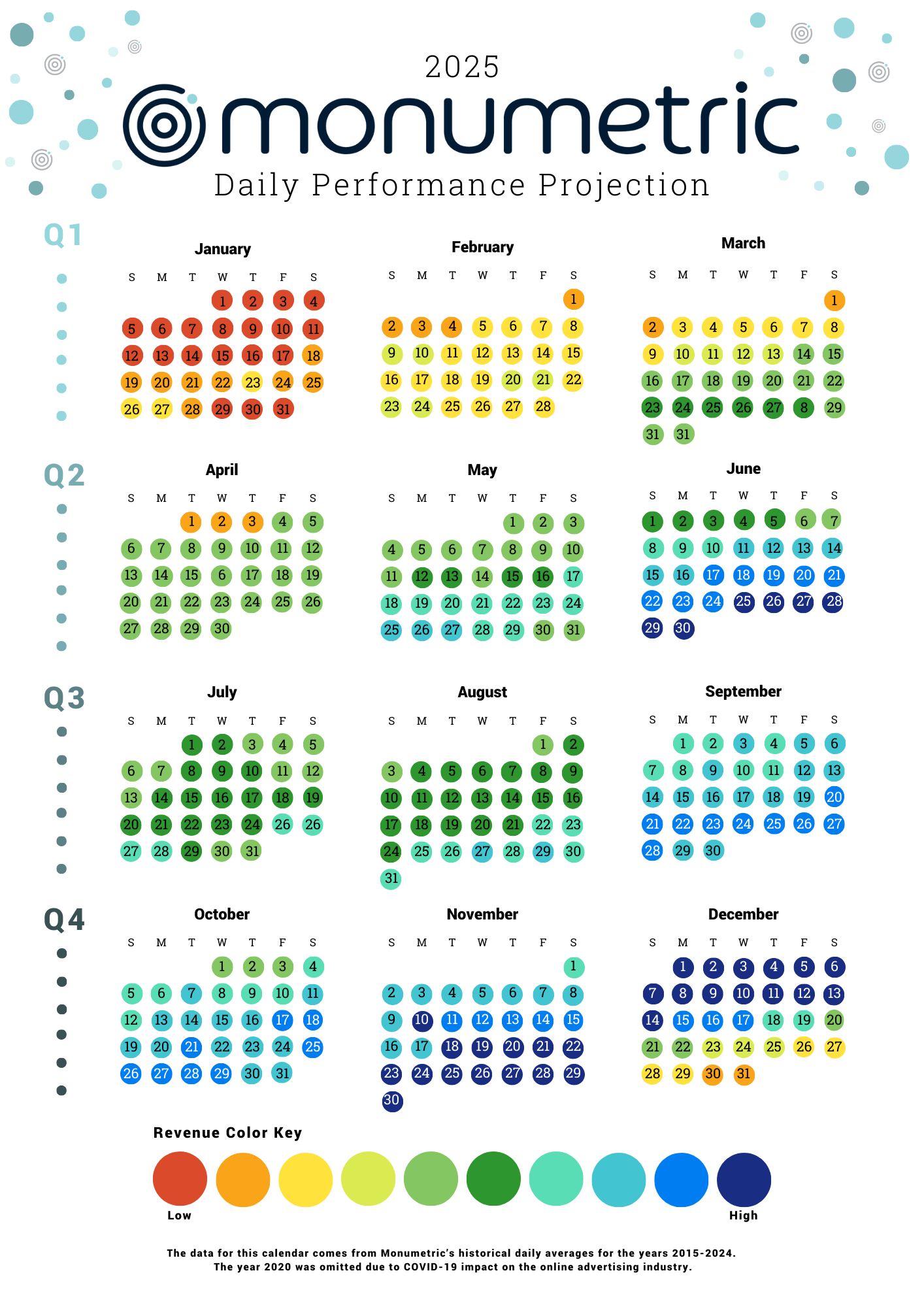Many people look forward to the new year as an opportunity for goals, growth and change. A fresh start can be so good for the soul! Then, like a thief in the night, decreased ad spend in the first quarter comes in to try and squander all the hopeful aspirations that accompany a new year. With more than ten years in the industry we understand the overarching disappointment of Q1 and have learned that with preparation and perspective it’s very possible to weather the Q1 storm and keep an optimistic view of continued growth throughout the year.
Every year, the timing of the slow down in ad spend around Christmas seems to change. You may have already noticed the downward turn in your Monumetric Console. This year we saw the largest dip around December 16th. Don’t take it personally though, ALL publishers around the world are seeing this same decrease in earnings and, in most cases, the dip will bottom out around 50%.
Depending on your years of experience as a publisher, this may or may not be a surprise. If you dwell on it too much, it can be very discouraging–especially when you learn there’s not a lot anyone can do about it. The Q1 earnings drop is one of, if not the most, consistent trend in the industry.
Every year we update the Monumetric Daily Performance Projection Calendar. It’s as close as we can get to helping you know what to expect in the coming year. This calendar was created from Monumetric’s historical daily averages from the years 2015 to 2024. 2020 was omitted for anomalous performance due to COVID-19 impacts on the online advertising industry.

Watch for those green-to-blue days to help you plan new post drops and reap the greatest rewards for your hard work and creativity. Here are some insights into advertising’s yearly highs and lows, and how it might affect you:
Why do earnings drop in Q1?
Think about it in terms of the average consumer. We all spend more during Q4 between the holidays and changing seasons. Advertisers know our wallets are open, so they’re willing to spend more money to get their advertisements in front of prospective customers. After the holidays, we experience the dry wallet epidemic and so do our ad providers. This means when Q1 starts, consumers and advertisers slow their spending.
Ad companies slash their budgets after the holiday rush, which means December’s plentiful CPMs and fill rates turn into a downright drought in a matter of days. The “quarterly budget dump” is a very real thing and there’s a reason why we accept this loss without question.
Ad agencies have budget spends each quarter and must spend every penny if they want the same budget at the beginning of the next quarter. This is why we often see CPM rates dip at the start of every quarter and rise again at the end of the next one.
Oh, how we all love the 4th quarter! Thanksgiving, Black Friday, Cyber Monday, Chanukah, and Christmas–all those big spender holidays happen at the end of the year, which means ad agencies’ budgets for Q4 are giant. That’s good news for you!
In some cases, we see advertisers spending up to 60% of their entire yearly budget in the 4th quarter.
We usually see the opposite happening in the first quarter. Companies reset budgets at the beginning of the year. And all those big spenders? Well, they just aren’t shopping. They are recovering from a season of spending, causing trends to decline drastically. This industry-wide trend has been coined “seasonality.”
Often, the discouragement comes from the feeling of a lack of control. However, you can add some control and perspective by having a plan for what’s coming. Understanding seasonality and being able to anticipate and plan for the slumps is helpful for your mental health and financial health. We don’t have a crystal ball, but we do have years of aggregated data and experience we can share with you to make seasonal trends more predictable.
Q1 (January–March)
This quarter starts off with the slowest performance rates of the year. Performance slowly increases throughout the quarter because people are inside most of the day, browsing the Internet (the affects of this type of spending on your earnings may vary based on your niche audience and what they are looking for.)
Q2 (April–June)
Quarter two will also see beginning-of-the-quarter lows, but quickly climbs to perform around the yearly average until the summer months approach. Part of this is due to more people heading on vacation and spending more of their free time outside, not online.
Q3 (July–September)
Traffic and earnings remain low, but can spike around holidays and improve sharply as back-to-school campaigns begin. As people return from vacation and start the regular “school session” period along with cooler weather, more individuals remain inside and begin spending more time online again.
Q4 (October–December)
This is almost always the best-performing quarter of the year. Performance starts around yearly averages near the beginning of the quarter but steadily climbs through December. The last week of December usually sags, as ad providers have spent their budgets and take an industry-wide holiday.
Content Strategy for 2025
Now that you’re armed with more information and some projections to predict the future, you can create an action plan. We know there is nothing we can do to stop these Q1 decreases, but there are some strategies you can implement that may help soften the blow and make the most of these ad spending trends.
- Be open to new ad strategies from your Success Team. There are almost always ways you can earn more with your digital advertising. By moving around your ad units, adding new units, or trying out new alternative ad placements, you can cushion the CPM dip by getting creative with your setup. Even if these are units you only plan on keeping during Q1, they can help tremendously during the slowest season of the year.
- Distribute your content heavily. Optimize your content with the same fervor you optimized toward the end of Q4, even if that’s every day. The drastic budget drop is intended to be a Band-Aid for ad agencies to make January less awful than it could be, but that doesn’t mean you can’t make money. Instead of simply giving up and spending Q1 on a month-long Netflix date, you can arm yourself and be ready! Focus on that great content and push it out there just as often as you did during Q4. Over time, you will see a difference in your earnings.
- Collaborate and work with brands. All year long, brands and other publishers are reaching out, wanting to work with you. This is a great time of year to nurture those relationships and build new ones. These opportunities can help cushion the blow on the Q1 dip.
- Start gearing up for Q2. This one may seem obvious, but planning for Q2 will help you stay ahead of the game and spark hope that higher rates are just a few weeks away. After a busy Q4, this is a good time to continue research and start talking strategy with new partners or within your own team. This way, you’ll be ready to improve your income when Q2 hits.
Don’t let Q1 bring you down. Don’t panic over declining rates. Remember, everyone’s in the same boat, and we all see these drastic changes. You are not alone!
Let us know in the comments what things you have done this year–or in the past–to help cushion your Q1 earnings.




